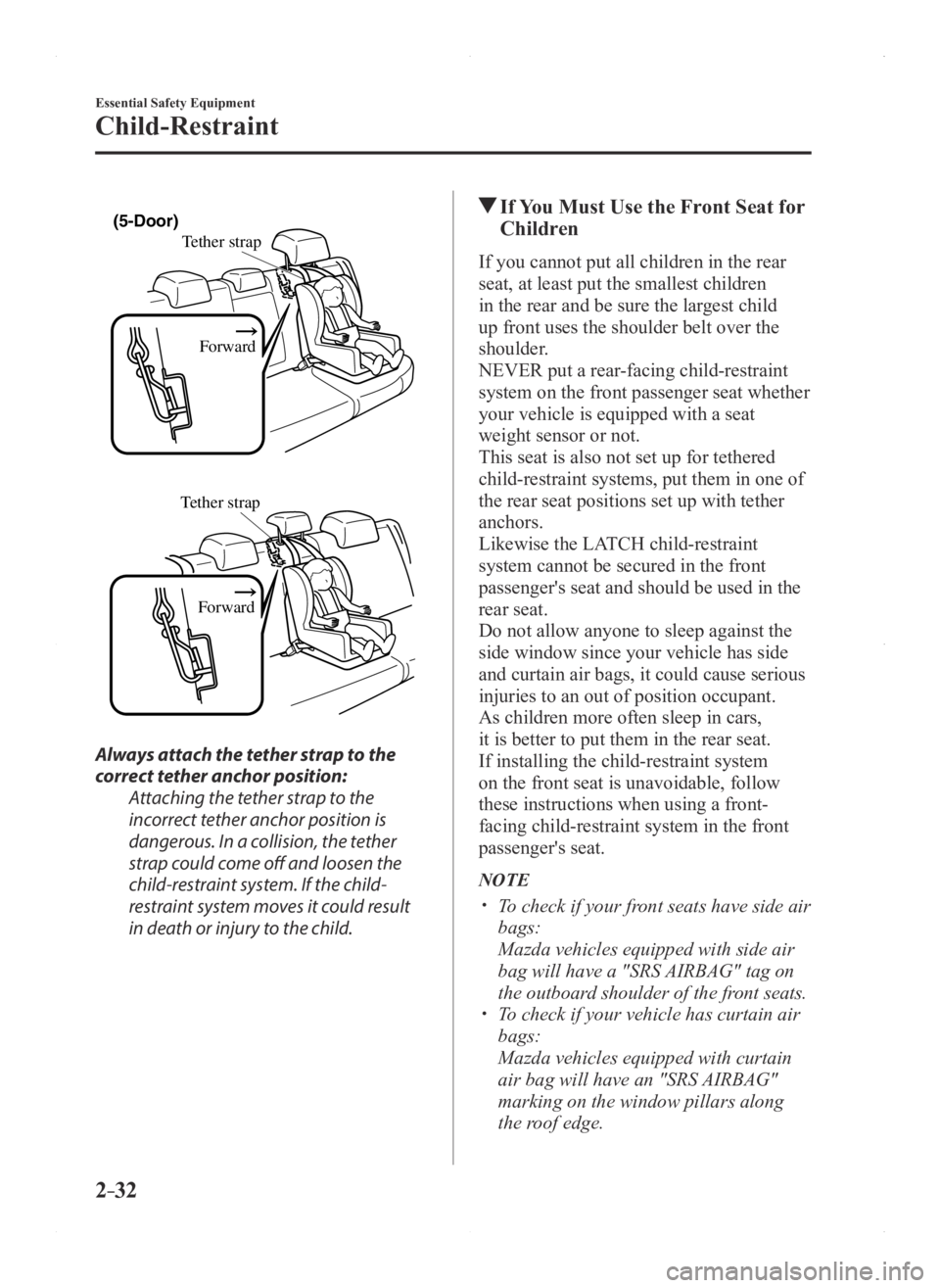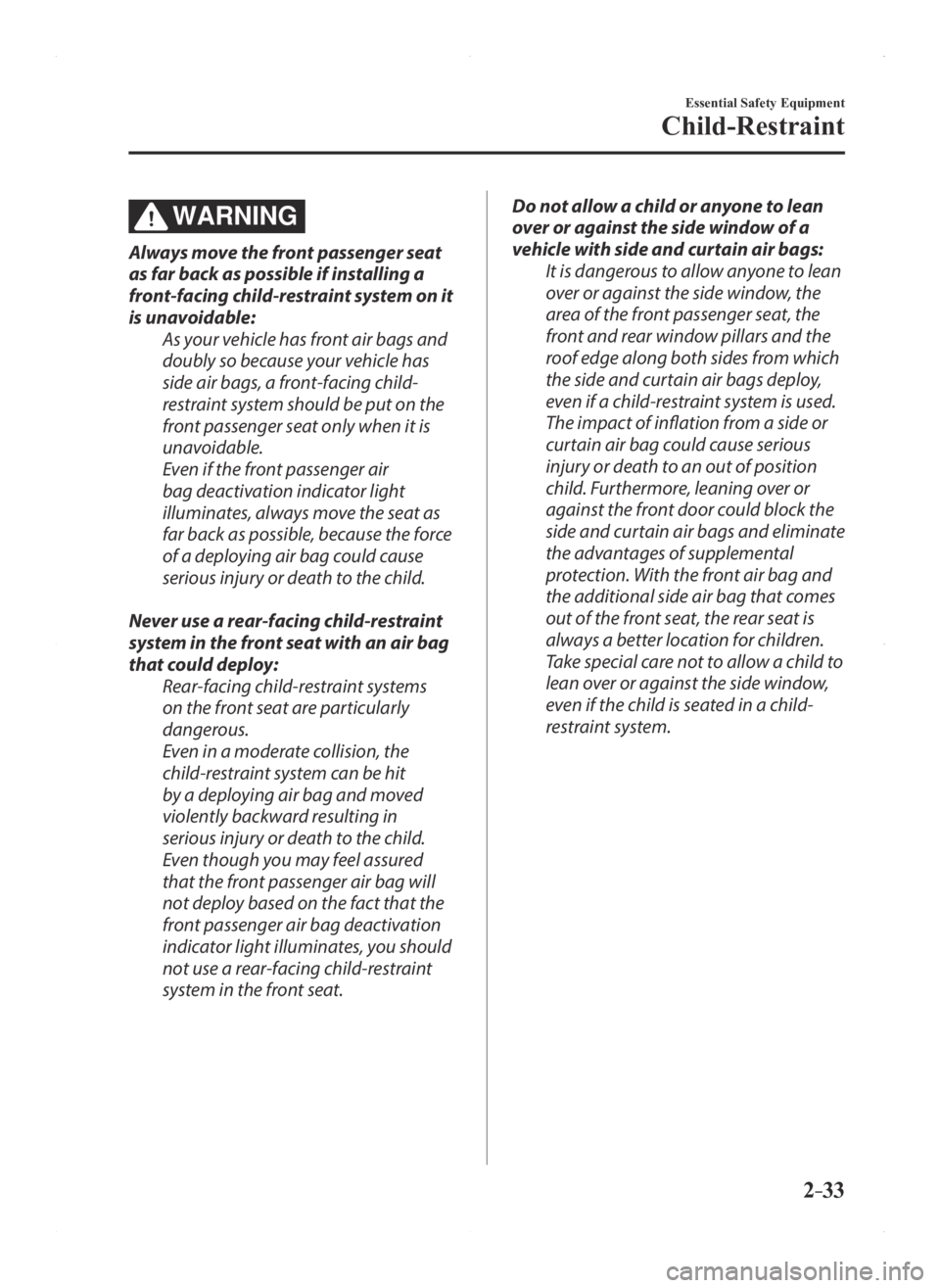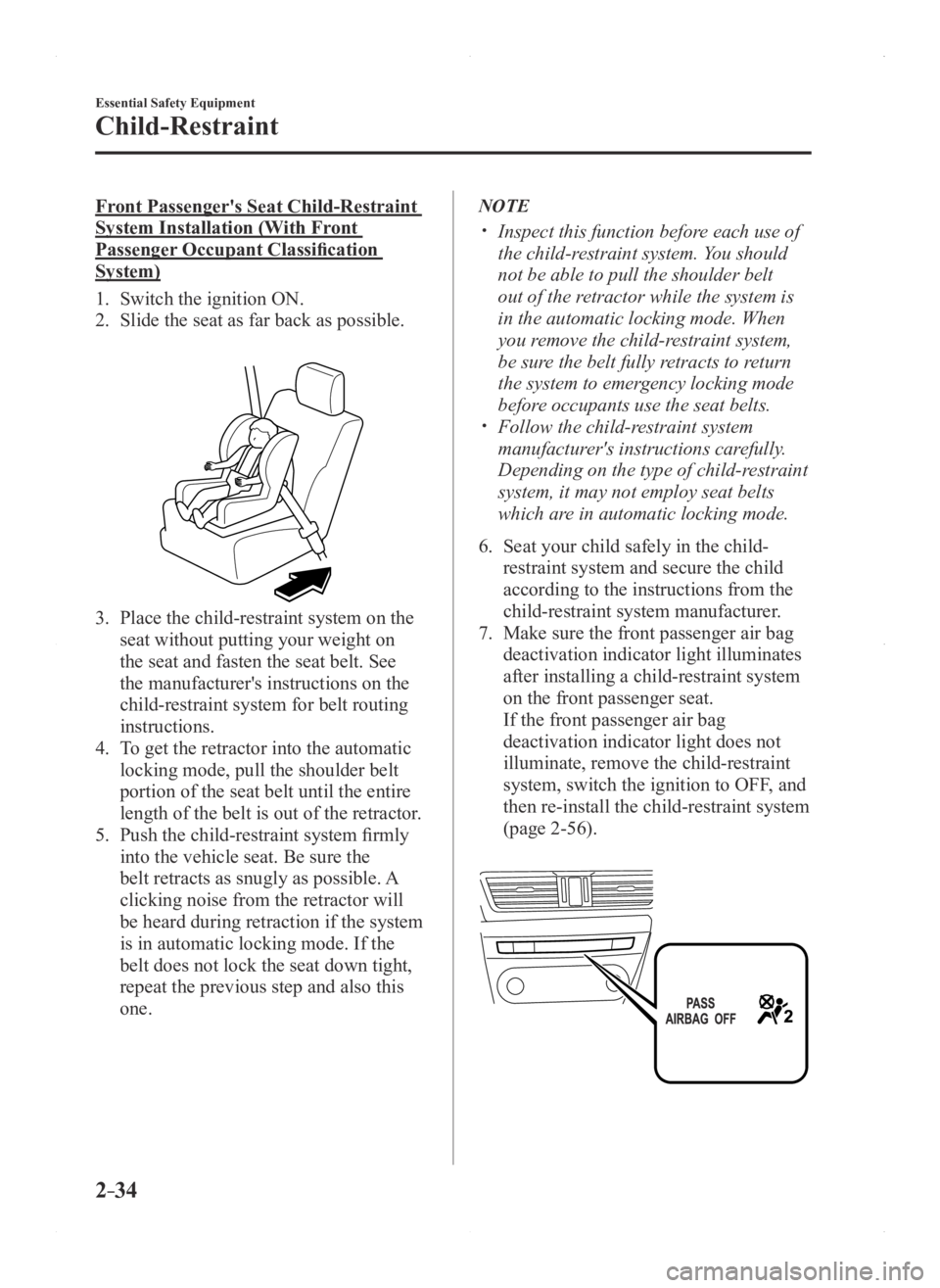MAZDA MODEL 3 4-DOOR 2016 Service Manual
Manufacturer: MAZDA, Model Year: 2016, Model line: MODEL 3 4-DOOR, Model: MAZDA MODEL 3 4-DOOR 2016Pages: 598, PDF Size: 30.13 MB
Page 41 of 598

2–27
Essential Safety Equipment
Child-Restraint
Child-Restraint System
Installation
Child-Restraint System Types
In this owner's manual, explanation of
child-restraint systems is provided for the
following three types of popular child-
restraint systems: infant seat, child seat,
booster seat.
NOTE
Installation position is determined
by the type of child-restraint system.
Always read the manufacturer's
instructions and this owner's manual
carefully.
Due to variations in the design of child-
restraint systems, vehicle seats and
seat belts, all child-restraint systems
may not fit all seating positions. Before
purchasing a child-restraint system, it
should be tested in the specific vehicle
seating position (or positions) where it
is intended to be used. If a previously
purchased child-restraint system does
not fit, you may need to purchase a
different one that will.
Infant seat
An infant seat provides restraint by
bracing the infant's head, neck and back
against the seating surface.
Child seat
A child seat restrains a child's body using
the harness.
Booster seat
A booster seat is a child restraint accessory
designed to improve the fit of the seat belt
system around the child's body.
Mazda3_8FA4-EA-15G_Edition1.indb 272015/05/11 14:00:06
Page 42 of 598

2–28
Essential Safety Equipment
Child-Restraint
Installing Child-Restraint
Systems
Accident statistics reveal that a child is
safer in the rear seat. The front passenger's
seat is clearly the worst choice for any
child under 12, and with rear-facing child-
restraint systems it is clearly unsafe due to
air bags.
NOTE
Even if your vehicle is equipped with front
passenger seat weight sensors (page
2-56), which automatically deactivates
the front passenger air bag, a rear seat is
the safest place for a child of any age or
size.
Some child-restraint systems now come
with tethers and therefore must be
installed on the seats that take tethers
to be effective. In your Mazda, tethered
child-restraint systems can only be
accommodated in the three positions on
the rear seat.
Some child-restraint systems also employ
specially designed LATCH attachments;
refer to "Using LATCH Lower Anchor"
(page 2-36).
WARNING
Tethered Child-Restraint Systems Work
Only on Tether-Equipped Rear Seats:Installation of a tether equipped
child-restraint system in the front
passenger's seat defeats the safety
design of the system and will result in
an increased chance of serious injury if
the child-restraint system goes forward
without benefit of being tethered.
Place tether equipped child-restraint
systems where there are tether
anchors.
Anchor Bracket
Anchor brackets for securing child-
restraint systems are equipped in the
vehicle. Locate each anchor position using
the illustration.
To install a child-restraint system,
always follow the instruction manual
accompanying the child-restraint system.
Anchor bracket location
Use the indicated anchor bracket locations
when installing a child-restraint system
equipped with a tether.
Anchor bracket For right
For left
For center
(4-Door)
Mazda3_8FA4-EA-15G_Edition1.indb 282015/05/11 14:00:07
Page 43 of 598

2–29
Essential Safety Equipment
Child-Restraint
(5-Door)For left
For centerFor rightSome models.
WARNING
Always attach the tether strap to the
correct tether anchor position: Attaching the tether strap to the
incorrect tether anchor position is
dangerous. In a collision, the tether
strap could come off and loosen the
child-restraint system. If the child-
restraint system moves it could result
in death or injury to the child. Always route the tether strap between
the head restraint and the seatback:
Routing the tether strap on top of
the head restraint is dangerous. In a
collision the tether strap could slide off
the head restraint and loosen the child-
restraint system. The child-restraint
system could move which may result in
death or injury to the child.
Anchor bracket
Tether strap(4-Door)
Anchor bracket
Tether strap
Mazda3_8FA4-EA-15G_Edition1.indb 292015/05/11 14:00:07
Page 44 of 598

2–30
Essential Safety Equipment
Child-Restraint
*Some models.
Tether strapForward
(5-Door)
Tether strap
Forward
Using Automatic Locking Mode*
Follow these instructions when using
a child-restraint system, unless you are
attaching a LATCH-equipped child-
restraint system to the rear LATCH lower
anchors. Refer to “Using LATCH Lower
Anchor” (page 2-36).
NOTE
Follow the child-restraint system
manufacturer's instructions carefully.
If you are not sure whether you have a
LATCH system or tether, check in the
child-restraint system manufacturer's
instructions and follow them accordingly.
Depending on the type of child-restraint
system, it may use LATCH system instead
of seat belts or if the belt goes across the
child's chest, may recommend against
using automatic locking mode.
1. Make sure the seatback is securely
latched by pushing it back until it is
fully locked.
2. Raise the head restraint to the top
locked position.
Refer to Head Restraints on page
2-11.
3. Secure the child-restraint system with
the lap portion of the lap/shoulder belt.
See the manufacturer's instructions
on the child-restraint system for belt
routing instructions.
4. To get the retractor into the automatic
locking mode, pull the shoulder belt
portion of the seat belt until the entire
length of the belt is out of the retractor.
Mazda3_8FA4-EA-15G_Edition1.indb 302015/05/11 14:00:08
Page 45 of 598

2–31
Essential Safety Equipment
Child-Restraint
5. Push the child-restraint system firmly
into the vehicle seat. Be sure the
belt retracts as snugly as possible. A
clicking noise from the retractor will be
heard during retraction if the system is
in the automatic locking mode. If the
belt does not lock the seat down tight,
repeat this step.
NOTE
Inspect this function before each use of
the child-restraint system. You should
not be able to pull the shoulder belt out
of the retractor while the system is in the
automatic locking mode. When you remove
the child-restraint system, be sure the
belt fully retracts to return the system to
emergency locking mode before occupants
use the seat belts.
6. If your child-restraint system requires
the use of a tether strap, refer to the
manufacturer's instructions to hook and
tighten the tether strap.
WARNING
Use the tether and tether anchor only
for a child-restraint system:Using the tether or tether anchor to
secure anything but a child-restraint
system is dangerous. This could
weaken or damage the tether or tether
anchor and result in injury.
Always route the tether strap between
the head restraint and the seatback: Routing the tether strap on top of
the head restraint is dangerous. In a
collision the tether strap could slide off
the head restraint and loosen the child-
restraint system. The child-restraint
system could move which may result in
death or injury to the child.
Anchor bracket
Tether strap(4-Door)
Anchor bracket
Tether strap
Mazda3_8FA4-EA-15G_Edition1.indb 312015/05/11 14:00:08
Page 46 of 598

2–32
Essential Safety Equipment
Child-Restraint
Tether strapForward
(5-Door)
Tether strap
Forward
Always attach the tether strap to the
correct tether anchor position: Attaching the tether strap to the
incorrect tether anchor position is
dangerous. In a collision, the tether
strap could come off and loosen the
child-restraint system. If the child-
restraint system moves it could result
in death or injury to the child.
If You Must Use the Front Seat for
Children
If you cannot put all children in the rear
seat, at least put the smallest children
in the rear and be sure the largest child
up front uses the shoulder belt over the
shoulder.
NEVER put a rear-facing child-restraint
system on the front passenger seat whether
your vehicle is equipped with a seat
weight sensor or not.
This seat is also not set up for tethered
child-restraint systems, put them in one of
the rear seat positions set up with tether
anchors.
Likewise the LATCH child-restraint
system cannot be secured in the front
passenger's seat and should be used in the
rear seat.
Do not allow anyone to sleep against the
side window since your vehicle has side
and curtain air bags, it could cause serious
injuries to an out of position occupant.
As children more often sleep in cars,
it is better to put them in the rear seat.
If installing the child-restraint system
on the front seat is unavoidable, follow
these instructions when using a front-
facing child-restraint system in the front
passenger's seat.
NOTE
To check if your front seats have side air
bags:
Mazda vehicles equipped with side air
bag will have a "SRS AIRBAG" tag on
the outboard shoulder of the front seats.
To check if your vehicle has curtain air
bags:
Mazda vehicles equipped with curtain
air bag will have an "SRS AIRBAG"
marking on the window pillars along
the roof edge.
Mazda3_8FA4-EA-15G_Edition1.indb 322015/05/11 14:00:09
Page 47 of 598

2–33
Essential Safety Equipment
Child-Restraint
WARNING
Always move the front passenger seat
as far back as possible if installing a
front-facing child-restraint system on it
is unavoidable:As your vehicle has front air bags and
doubly so because your vehicle has
side air bags, a front-facing child-
restraint system should be put on the
front passenger seat only when it is
unavoidable.
Even if the front passenger air
bag deactivation indicator light
illuminates, always move the seat as
far back as possible, because the force
of a deploying air bag could cause
serious injury or death to the child.
Never use a rear-facing child-restraint
system in the front seat with an air bag
that could deploy: Rear-facing child-restraint systems
on the front seat are particularly
dangerous.
Even in a moderate collision, the
child-restraint system can be hit
by a deploying air bag and moved
violently backward resulting in
serious injury or death to the child.
Even though you may feel assured
that the front passenger air bag will
not deploy based on the fact that the
front passenger air bag deactivation
indicator light illuminates, you should
not use a rear-facing child-restraint
system in the front seat. Do not allow a child or anyone to lean
over or against the side window of a
vehicle with side and curtain air bags:
It is dangerous to allow anyone to lean
over or against the side window, the
area of the front passenger seat, the
front and rear window pillars and the
roof edge along both sides from which
the side and curtain air bags deploy,
even if a child-restraint system is used.
The impact of inflation from a side or
curtain air bag could cause serious
injury or death to an out of position
child. Furthermore, leaning over or
against the front door could block the
side and curtain air bags and eliminate
the advantages of supplemental
protection. With the front air bag and
the additional side air bag that comes
out of the front seat, the rear seat is
always a better location for children.
Take special care not to allow a child to
lean over or against the side window,
even if the child is seated in a child-
restraint system.
Mazda3_8FA4-EA-15G_Edition1.indb 332015/05/11 14:00:09
Page 48 of 598

2–34
Essential Safety Equipment
Child-Restraint
Front Passenger's Seat Child-Restraint
System Installation (With Front
Passenger Occupant Classification
System)
1. Switch the ignition ON.
2. Slide the seat as far back as possible.
3. Place the child-restraint system on the
seat without putting your weight on
the seat and fasten the seat belt. See
the manufacturer's instructions on the
child-restraint system for belt routing
instructions.
4. To get the retractor into the automatic
locking mode, pull the shoulder belt
portion of the seat belt until the entire
length of the belt is out of the retractor.
5. Push the child-restraint system firmly
into the vehicle seat. Be sure the
belt retracts as snugly as possible. A
clicking noise from the retractor will
be heard during retraction if the system
is in automatic locking mode. If the
belt does not lock the seat down tight,
repeat the previous step and also this
one.
NOTE
Inspect this function before each use of
the child-restraint system. You should
not be able to pull the shoulder belt
out of the retractor while the system is
in the automatic locking mode. When
you remove the child-restraint system,
be sure the belt fully retracts to return
the system to emergency locking mode
before occupants use the seat belts.
Follow the child-restraint system
manufacturer's instructions carefully.
Depending on the type of child-r estraint
system, it may not employ seat belts
which are in automatic locking mode.
6. Seat your child safely in the child-
restraint system and secure the child
according to the instructions from the
child-restraint system manufacturer.
7. Make sure the front passenger air bag
deactivation indicator light illuminates
after installing a child-restraint system
on the front passenger seat.
If the front passenger air bag
deactivation indicator light does not
illuminate, remove the child-restraint
system, switch the ignition to OFF, and
then re-install the child-restraint system
(page 2-56).
Mazda3_8FA4-EA-15G_Edition1.indb 342015/05/11 14:00:09
Page 49 of 598

2–35
Essential Safety Equipment
Child-Restraint
WARNING
Do not seat a child in a child-restraint
system on the front passenger seat if the
front passenger air bag deactivation
indicator light does not illuminate:While it is always better to install any
child-restraint system on the rear seat,
it is imperative that a child-restraint
system ONLY be used on the front
passenger seat if the deactivation
indicator light illuminates when the
child is seated in the child-restraint
system (page 2-56). Seating a child
in a child-restraint system installed
on the front passenger seat with the
front passenger air bag deactivation
indicator light not illuminated is
dangerous. If this indicator light does
not illuminate, this means that the
front passenger front and side air
bags, and seat belt pretensioner are
ready for deployment. If an accident
were to deploy an air bag, a child in
a child-restraint system sitting in the
front passenger seat could be seriously
injured or killed. If the indicator light
does not illuminate after seating a
child in a child-restraint system on
the front passenger seat, seat a child
in a child-restraint system on the rear
seat and consult an Authorized Mazda
Dealer as soon as possible.
Mazda3_8FA4-EA-15G_Edition1.indb 352015/05/11 14:00:09
Page 50 of 598

2–36
Essential Safety Equipment
Child-Restraint
Using LATCH Lower Anchor
Your Mazda is equipped with LATCH lower anchors for attachment of specially designed
LATCH child-restraint systems in the rear seats. Both anchors must be used, otherwise the
seat will bounce around and put the child in danger. Most LATCH child-restraint systems
must also be used in conjunction with a tether to be effective. If they have a tether you must
use it to better assure your child's safety.
WARNING
Follow the manufacturer's instructions for the use of the child-restraint system:
An unsecured child-restraint system is dangerous. In a sudden stop or a collision it could
move causing serious injury or death to the child or other occupants. Make sure the
child-restraint system is properly secured in place according to the child-restraint system
manufacturer's instructions.
Never attach two child-restraint systems to the same LATCH lower anchor: Attaching two child-restraint systems to the same LATCH lower anchor is dangerous.
In a collision, one anchor may not be strong enough to hold two child-restraint system
attachments, and it may break, causing serious injury or death. If you use the seat
position for another child-restraint system when an outboard LATCH position is occupied,
use the center seat belts instead, and the tether if tether-equipped.
Make sure the child-restraint system is properly secured: An unsecured child-restraint system is dangerous. In a sudden stop or a collision it could
move causing serious injury or death to the child or other occupants. Follow the child-
restraint system manufacturer's instructions on belt routing to secure the seat just as you
would with a child in it so that nobody is tempted to put a child in an improperly secured
seat later on. When not in use, remove it from the vehicle or fasten it with a seat belt, or
latch it down to BOTH LATCH lower anchors for LATCH child-restraint systems.
Make sure there are no seat belts or foreign objects near or around the LATCH child-
restraint system: Not following the child-restraint system manufacturer's instructions when installing
the child-restraint system is dangerous. If seat belts or a foreign object prevent the
child-restraint system from being securely attached to the LATCH lower anchors and the
child-restraint system is installed improperly, the child-restraint system could move in a
sudden stop or collision causing serious injury or death to the child or other occupants.
When installing the child-restraint system, make sure there are no seat belts or foreign
objects near or around the LATCH lower anchors. Always follow the child-restraint system
manufacturer's instructions.
Mazda3_8FA4-EA-15G_Edition1.indb 362015/05/11 14:00:09